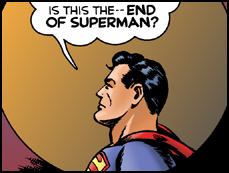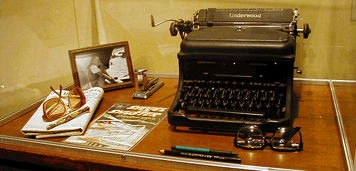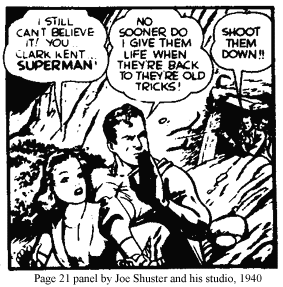
THE MOST IMPORTANT SUPERMAN STORY EVER WRITTEN!
SPOILERS BELOW!
This article contains many SPOILERS to "The K-Metal From Krypton."
If you haven't read the story yet and don't want to know what's going to happen
in it, Conventional Supermanic History tells us that Kryptonite, Superman's one major weakness—a piece of mineral from his home planet—was created fully formed from the writers of the Superman Radio Show in 1943 and first appeared in the Superman comic books in 1949. It tells us that Superman never learned that he came from an alien planet—nor that said planet was named "Krypton"—until 1949. And it also tells us that Lois Lane never learned that Superman and Clark Kent are one-and-the-same until sometime in the 1990s. If Jerry Siegel, who created Superman with Joe Shuster, had his way, all of these events, and more, would have occurred in 1940—but "The K-Metal from Krypton" was never published. There are a number of other historical missing links revealed in this story. Any one of them, taken alone, would mark the tale as one of the most important historical finds in Superman's history: It marks the very first time that editor Perry White's name, in any form, is used. Prior to this script, and in Jerry Siegel's plot synopsis of this very story, Clark's Boss was George Taylor. In the chronicles as they were published, the editor-in-chief's name was first presented as "George Taylor," then it evolved into "Taylor"—from there to "White" and finally to "Perry White." But this script reveals that Perry's first name was known far in advance of its actual first use in a published story, prior even to the lone "White." The story also shows an important development in Superman's powers. Here, instead of merely "leaping," Superman is capable of "sky-jumps," an important milestone on his way to full flight capability.
an important milestone on his way to full flight capability.
But there are much larger changes that show this script to be the most important Superman story ever written. In "The K-Metal from Krypton," as a meteor from Krypton approaches Earth, Superman learns for the very first time what it is like to lose his powers. He goes through confusion, pain, and emotional turmoil like none we have seen in later stories. He debates about whether or not to continue as Superman without his powers. And in a scene showing what truly makes Superman "Superman," he chooses to continue on with the name and costume even though, as far as he knows, he will remain forever without his Super-Powers. He also learns, for the first time, that he comes from an alien planet; and that this mysterious substance must be from that same planet. 
K-Metal itself, unlike the later variety of everyday Green Kryptonite, not only causes Superman to lose his powers—it also causes normal, non-powered humans to gain Super-Powers. This secondary feature of the metal would very rarely be used with Kryptonite in the comic books—generally only with animals—and would not gain wide-usage until the Smallville television show. DC's Editorial Director, Whitney Ellsworth, had read the K-Metal script and was intimately familiar with its contents. Ellsworth was also producer, script editor, and frequent ghost-writer of both the Superman Radio show and the later Adventures of Superman television series. It's likely that 1940's introduction of K-Metal was the inspiration not only for various incarnations of Kryptonite in various media (the Radio Show, the comics, and Smallville), but that the plot concept of Superman facing emotional and mental challenges—internally debating with himself about his role and his feelings—in the face of an approaching meteor from space that has unpredictible effects on him was also used in the 1953 George Reeves episode, Panic in the Sky and in the later 1994 Lois and Clark episode, All Shook Up. In The Deadly Rock, a follow-up episode to the original George Reeves Panic in the Sky episode, a fragment from the Kryptonite meteor has arrived on Earth and effects not only Superman, but his friend Gary Allen. When exposed to this fragment of Kryptonite, Mr. Allen is impervious to all harm and is invulnerable to gunfire. In the episode, no explanation is provided for why an earthman should be effected by Kryptonite in this manner. The not-necesarily unrelated idea of an approaching meteor presenting a threat from Superman's home planet was also obviously inspired by "The K-Metal from Krypton." This idea was re-used in many comic books stories (most recently in Jeph Loeb's introduction of the latest Supergirl) and served as the major plot element in the unproduced George Reeves movie, Superman and the Secret Planet. Planetoid-sized fragments of Krypton also played a role in the 2006 movie, Superman Returns, although the scenes were cut from the final release. But these were not the only major changes to the legend.
"The K-Metal from Krypton" evolved the relationship between Superman and Lois Lane. Having completed his soul-searching and faced with impending disaster, Superman sacrifices his secret identity to Lois in order to facilitate her rescue. Not a hoax, not a dream—and not an imaginary story. For real. But rather than the reaction that one might expect, Lois isn't necessarily pleased at having been
played the fool.
As Gerard Jones makes clear in Men of Tomorrow—that moment when DC pulled this story from publication was the same moment that the guiding control of Superman's destiny was forever removed from his creators. Article by Great Rao, 2005 |



